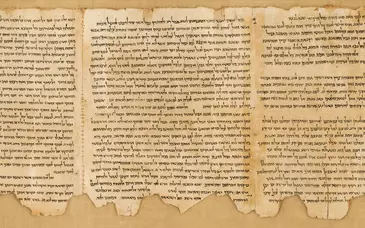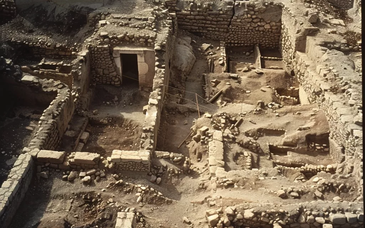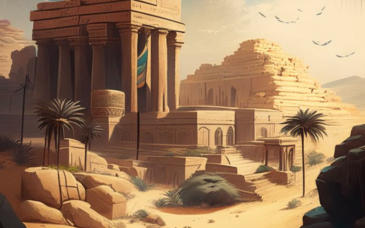This section of the presentation includes an in-depth look at those panels of Acts that were outlined briefly in the introduction.
Transition, Including a Brief Visit to Ephesus (18:18-23)
18 After this Paul stayed many days longer, and then took leave of the brethren and sailed for Syria, and with him Priscilla and Aquila. At Cenchreae he cut his hair, for he had a vow. 19 And they came to Ephesus, and he left them there; but he himself went into the synagogue and argued with the Jews. 20 When they asked him to stay for a longer period, he declined; 21 but on taking leave of them he said, "I will return to you if God wills," and he set sail from Ephesus. 22 When he had landed at Caesarea, he went up and greeted the church, and then went down to Antioch. 23 After spending some time there he departed and went from place to place through the region of Galatia and Phrygia, strengthening all the disciples. (RSV)
The main details of this panel are (1) that Paul leaves Corinth via Cenchrea, (2) Priscilla and Aquila accompany him to Ephesus, and (3) Paul has success teaching in the synagogue.
Excursus: The Harbor
During this visit, Paul sailed in and out of Ephesus, and so would have been very acquainted with the harbor. The harbor was a key part of the ancient city of Ephesus. Much of the activity in the harbor included receiving grain supply from Egypt and ceramic vessels that were imported and exported (Zabehlicky, 213). There is evidence of a customs house based on the fishermen's guild stele (Horsley "Fishing," 103). The major problem with the harbor was the silt deposited from Cayster River was rendering it useless. The ancients understood the silting problem and made various attempts at ameliorating the situation, which ended up only exacerbating it (Hemer Letters, 36). Today, the ancient harbor is separated from the Aegean by about two or three miles of "reedy marshland" (Blaiklock, 154) and, at least in Ramsay's day, the shoreline was sandy and harborless—definitely an unapproachable location for a vessel (Ramsay Letters, 214).
The main significance of this panel is that it establishes a preliminary connection of Paul in Ephesus. Very little detail is given about Paul in the city, however, the reader is now prepared for Paul's extended ministry which will occur in the narrative shortly.
24 Now a Jew named Apollos, a native of Alexandria, came to Ephesus. He was an eloquent man, well versed in the scriptures. 25 He had been instructed in the way of the Lord; and being fervent in spirit, he spoke and taught accurately the things concerning Jesus, though he knew only the baptism of John. 26 He began to speak boldly in the synagogue; but when Priscilla and Aquila heard him, they took him and expounded to him the way of God more accurately. 27 And when he wished to cross to Achaia, the brethren encouraged him, and wrote to the disciples to receive him. When he arrived, he greatly helped those who through grace had believed, 28 for he powerfully confuted the Jews in public, showing by the scriptures that the Christ was Jesus. (RSV)
Here we have Apollos, a Jew from Alexandria, who came to Ephesus. He taught accurately about Jesus, though he was only familiar with John's baptism. Accordingly, Priscilla and Aquila taught him more accurately, and he later traveled to Corinth.
Luke does two things in his narrative with this story. First he shows that Christianity in Ephesus was in existence before the Pauline mission. He is careful not to credit Paul with founding the church in that city, yet the form of Christianity that was there needed correction. Priscilla and Aquila are representative of Paul's mission. The second thing that Luke accomplishes with this narrative is he establishes the origins the Apollos and Corinth connection (cf. 1 Cor. 1:12; 3:4-6, 22; 4:6; 16:12).
1 While Apollos was at Corinth, Paul passed through the upper country and came to Ephesus. There he found some disciples. 2 And he said to them, "Did you receive the Holy Spirit when you believed?" And they said, "No, we have never even heard that there is a Holy Spirit." 3 And he said, "Into what then were you baptized?" They said, "Into John's baptism." 4 And Paul said, "John baptized with the baptism of repentance, telling the people to believe in the one who was to come after him, that is, Jesus." 5 On hearing this, they were baptized in the name of the Lord Jesus. 6 And when Paul had laid his hands upon them, the Holy Spirit came on them; and they spoke with tongues and prophesied. 7 There were about twelve of them in all. (RSV) (RSV)
Paul returns to Ephesus, where he finds disciples of John the Baptist. He tells them about Jesus and they are baptized and receive the Holy Spirit.
Excursus: Paul's Route
It was around the year 53 C.E. that Paul entered the city for the second time. His first visit was by ship, but in this second extended visit he entered by way of land from Antioch of Syria. Acts 19.1 states that Paul traveled through the inland country (ta anōterika merē), which Ramsay notes was the "higher-lying and more direct route" as opposed to the trade route that ran through the Lycus and Maeander valleys (Ramsay St. Paul, 265).
Again, Luke shows that a form of Christianity was being promoted in Ephesus, yet it was a powerless version. Paul, like Peter and John in 8:17, laid hands on the disciples of John and they took hold of the Holy Spirit. So, the disciples in Ephesus benefitted greatly by Paul's mission.
Paul Teaches in the City (19:8-10)
8 And he entered the synagogue and for three months spoke boldly, arguing and pleading about the kingdom of God; 9 but when some were stubborn and disbelieved, speaking evil of the Way before the congregation, he withdrew from them, taking the disciples with him, and argued daily in the hall of Tyrannus. 10 This continued for two years, so that all the residents of Asia heard the word of the Lord, both Jews and Greeks. (RSV)
Paul taught in the synagogue for three months, until he and "the Way" are resisted. He withdrew and taught in the Hall of Tyrannus, which took place for two years.
Excursus: The Ephesian Synagogue
There is mixed evidence of a synagogue in Ephesus. It appears that Antiochus placed a body of Jews in Ephesus as citizens (Ramsay Letters, 235), and Hemer confirms the likelihood that at least some Jews possessed citizenship since the times of the Seleucids (Hemer Letters, 36-41). Tcherikover, basing his evidence on Josephus (Ant. 14.213, 225-264; 16.6), also notes the populations of Jews in Ephesus (Tcherikover, 288). Despite strong literary evidence of a Jewish presence, there is little epigraphical data for the presence of Jews in the city (Horsley New Documents, 231). Yet, Strelan notes that the size of grouping would have been relatively small, and agrees with Overman on the subject of synagogues, stating, "we should not envisage a full-blown sophisticated institution when we encounter this word in first and second century documents" (Strelan, 16; Overman, 57). Therefore, Jews made up a portion of the population in Ephesus, but probably met in small, rather than large (archaeologically extant), buildings. Paul's tenure in the synagogue only lasted three months before upsetting some of the members.
Excursus: The Hall of Tyrannus
After a falling out in the synagogue, Paul is forced to find a suitable place to continue his teaching. Acts 19:9 points to this new location: "When some stubbornly refused to believe and spoke evil of the Way before the congregation, he left them, taking the disciples with him, and argued daily in the lecture hall (scholē) of Tyrannus." Paul is depicted as a wandering philosopher (Conzelmann, 163), moving from the Synagogue to the scholē tou Tyrannou. There has been a substantial amount of discussion as to what the scholē actually refers. The major theories regarding the hall of Tyrannus is that it was (1) a lecture hall named after its owner, (2) a lecture hall named after the person who lectured in it most frequently such as a local philosopher, (3) a school, and (4) a guildhall. Whatever the scholē actually was, Paul made some sort of arrangement to secure it as a consistent speaking venue.
The Western text has the insertion that he "argued daily in the hall of Tyrannus from the fifth hour to the tenth (tinos apo hōras e heōs dekatēs)," which translates to our time scheme as 10:00 a.m. to 4:00 p.m. Metzger notes that it "may represent an accurate piece of information, preserved in oral tradition before being incorporated into the text of certain manuscripts" (Metzger, 470). Based on this Western addition, it seems that Paul would have worked the normal working hours (probably with his tent-making trade) and lectured during the hours that people would have spent eating their midday meal and participating in the siesta (cf. Martial Epigrams, 4.8.3). The normal lecturer himself (Tyrannus?) would have utilized the hall at normal teaching hours along the same lines as the standard working hours (i.e., before the siesta).
Haenchen brings up a few points regarding the logistics of Paul renting a lecture hall and still working in the morning:
Even if Paul 'worked in leather' from early morning to 11.0 a.m. and as far as possible from 4.0 p.m. on, the wages would not have been sufficient to furnish a livelihood for him and his companions and to meet the cost of rent. The congregation must have contributed substantially—Aquilla and Priscilla were indeed not without means, and also we must not underestimate the liberality of a young community. But here again Luke lets all the limelight fall upon Paul. (Haenchen, 561).
These are interesting questions to consider, however, Luke does not tell us much information regarding the circumstances of the scholē tou Tyrannou and so any number of hypothetical questions may be asked. Regarding Haenchen's comments, Marshall writes that he "fails to reckon that Tyrannus may have been a Christian or a sympathizer who made little or no charge for the use of his premises (especially at a time when he would not be using them himself)" (Marshall, 309).
The translator must resist the tendency to translate scholē here as "school." It is true that this is the word from which "school" is derived, yet that is not the intended meaning here, though some have argued so. It is more accurately understood as a hall that was used for lectures or other types of meetings (Lake and Cadbury, 239).
What do we know about this hall? What do we know about this Tyrannus? So far, no clear-cut evidence of a hall of Tyrannus has been discovered. Williams argues that a parent naming a child "Tyrannus" (Tyrant) would be a cruel jester and so it must be taken as a nickname (Williams, 495), yet the term "tyrant" did not have the same connotations in the ancient world and, as Yamauchi rightly notes, the name is common in Ephesus (Yamauchi "Tyrannus," 6:686). The mere fact that the name "Tyrannus" is found in first century C.E. inscriptions in Ephesus gives credence to the reliability of such a place (Hemer Acts, 234; Trebilco Ephesus, 144; cf. Horsley "Fishing," 113).
Anything more about the hall of Tyrannus is simply speculation. Rackham points to the fact that Ephesus had no less than five gymnasia and argues for the possibility that the hall of Tyrannus would have been located in one of them (Rackham, 351). Malherbe refers to it as a guildhall and not a lecture hall (Malherbe, 89-91; cf. Harland, 38-40). Strelan suggests that since there is evidence of a Greek in Caesarea owning a synagogue, this too may be a situation of a gentile (Tyrannus) owning a synagogue who allowed Paul to use one of its room for his scholē (Strelan, 253). There is also the possibility of a lecture hall (audeitōrion) adjoining the Library of Celsus, but this is unlikely of any help to us. Lüdemann quotes Schille who says that it may be the name of a synagogue, a place for pagan cult associations, or an auditorium (Lüdemann, 213). Nevertheless, Paul taught at this scholē for two years according to 19:10.
The message was received by some, but rejected by others. This is a common motif in Luke-Acts and it is no different in Ephesus. Even though Paul was resisted, his work in the Hall of Tyrannus, which continued for two years, had very signficant results. First, Acts states that all of Asia heard the word of the Lord. For the first time, the message of Paul's preaching is spread throughout the entire province. The second notable item that is equally substantial is that the message affected both Jews and Gentiles (Greeks).
11 And God did extraordinary miracles by the hands of Paul, 12 so that handkerchiefs or aprons were carried away from his body to the sick, and diseases left them and the evil spirits came out of them. 13 Then some of the itinerant Jewish exorcists undertook to pronounce the name of the Lord Jesus over those who had evil spirits, saying, "I adjure you by the Jesus whom Paul preaches." 14 Seven sons of a Jewish high priest named Sceva were doing this. 15 But the evil spirit answered them, "Jesus I know, and Paul I know; but who are you?" 16 And the man in whom the evil spirit was leaped on them, mastered all of them, and overpowered them, so that they fled out of that house naked and wounded. 17 And this became known to all residents of Ephesus, both Jews and Greeks; and fear fell upon them all; and the name of the Lord Jesus was extolled. 18 Many also of those who were now believers came, confessing and divulging their practices. 19 And a number of those who practiced magic arts brought their books together and burned them in the sight of all; and they counted the value of them and found it came to fifty thousand pieces of silver. 20 So the word of the Lord grew and prevailed mightily. (RSV)
Luke demonstrates that God performed healings through the hands of Paul. Then seven sons of a Jewish priest (Sceva) tried to harnass the same power that Paul utilized, but they failed. Though the sons of Sceva were met with disastrous results, it says that Jesus was extolled. Then people became members of "the Way" and burned their magic books.
Luke accomplishes a few notable things in this narrative. First he shows that God did extraordinary miracles through Paul. Even though the emphasis is rightly placed on God, Paul, who is Luke's hero in a sense, is further validated as a minister of God because of it. The subject of magic is re-introduced to the scene. Magic, as in the past narrative of Acts, stands no chance against power of the gospel. But the results of this episode are clear: all the residents of Ephesus learned about Paul's ministry and "the Way." Additionally, the word of the Lord continued to increase and prevail mightily.
Paul's Travel Plans (19:21-22)
21 Now after these events Paul resolved in the Spirit to pass through Macedonia and Achaia and go to Jerusalem, saying, "After I have been there, I must also see Rome." 22 And having sent into Macedonia two of his helpers, Timothy and Erastus, he himself stayed in Asia for a while. (RSV)
Though this section is relatively short, many details are covered about Paul's mission and travel plans. First Paul decided to go to Jerusalem by way of Greece, however, his larger plans are to get to Rome. Instead, Paul sent Timothy and Erastus to Macedonia but himself stayed in Ephesus.
There is much importance to this small section. It shows how Paul stayed in Ephesus as a possible allusion to 2 Cor. 2:1, where Paul decides "not to make another painful visit" to Corinth. Of greater importance to the Lukan narrative, Paul sets his sights on Rome. He says, he "must" (dei = it is necessary) see Rome! For Acts, Rome is the goal and destination of the narrative as it represents "the end of the earth" (1:8).
Demetrius and the Riot (19:23-41)
23 About that time there arose no little stir concerning the Way. 24 For a man named Demetrius, a silversmith, who made silver shrines of Artemis, brought no little business to the craftsmen. 25 These he gathered together, with the workmen of like occupation, and said, "Men, you know that from this business we have our wealth. 26 And you see and hear that not only at Ephesus but almost throughout all Asia this Paul has persuaded and turned away a considerable company of people, saying that gods made with hands are not gods. 27 And there is danger not only that this trade of ours may come into disrepute but also that the temple of the great goddess Artemis may count for nothing, and that she may even be deposed from her magnificence, she whom all Asia and the world worship." 28 When they heard this they were enraged, and cried out, "Great is Artemis of the Ephesians!" 29 So the city was filled with the confusion; and they rushed together into the theater, dragging with them Gaius and Aristarchus, Macedonians who were Paul's companions in travel. 30 Paul wished to go in among the crowd, but the disciples would not let him; 31 some of the Asiarchs also, who were friends of his, sent to him and begged him not to venture into the theater. 32 Now some cried one thing, some another; for the assembly was in confusion, and most of them did not know why they had come together. 33 Some of the crowd prompted Alexander, whom the Jews had put forward. And Alexander motioned with his hand, wishing to make a defense to the people. 34 But when they recognized that he was a Jew, for about two hours they all with one voice cried out, "Great is Artemis of the Ephesians!" 35 And when the town clerk had quieted the crowd, he said, "Men of Ephesus, what man is there who does not know that the city of the Ephesians is temple keeper of the great Artemis, and of the sacred stone that fell from the sky? 36 Seeing then that these things cannot be contradicted, you ought to be quiet and do nothing rash. 37 For you have brought these men here who are neither sacrilegious nor blasphemers of our goddess. 38 If therefore Demetrius and the craftsmen with him have a complaint against any one, the courts are open, and there are proconsuls; let them bring charges against one another. 39 But if you seek anything further, it shall be settled in the regular assembly. 40 For we are in danger of being charged with rioting today, there being no cause that we can give to justify this commotion." 41 And when he had said this, he dismissed the assembly. (RSV)
"The Way" has now caused a huge disturbance. Luke literally says, "no little commotion," wherein he employs the figure of speech called litotes. Litotes is common in Greek literature and especially in Acts (cf. 12:18; 21:39; Barrett, 1:588; Cadbury 120-121.), where one emphasizes something by putting stress on a negation of its opposite. Here Demetrius has gathered together a group and makes a complaint against Paul. This leads to a large gathering, or riot, in the theatre, where the residents of Ephesus shout, "Great is Artemis of the Ephesians!" As a result, the city clerk calms the people down and dismisses them.
Excursus: Demetrius' Shrines
According to Luke, Demetrius was a silversmith that made silver shrines (naous argurous) for Artemis. Munck points out that some have doubted the validity of silver shrines, since only miniature terra cotta (not silver) temples have been found (Munck, 194). Yet silver was a precious metal that was could have easily been melted and reused for another application which would explain why none of the silver shrines are extant today. However, Munck has another explanation for this and argues that it is possibly a case of mistaken identity. Since the substantive "builder of temples" was used for the guardians of the Artemision, he states that Luke may have misinterpreted Demetrius's title (meaning "temple guardian") as "temple builder," alluding to an inscription from the middle of the first century C.E. which refers to a "temple builder" named Demetrius (Munck, 194-5). He concludes by saying that it is more likely that Demetrius made silver statues of Artemis than temples (Munck, 195; cf. Bruce, 374). To this Koester adds that it is unlikely that the silversmiths made "small-scale models of the entire temple" but rather made statues of Artemis residing small and simple naiskos (Koester "Ephesos," 130). In Tarentum there is an inscription in both Latin and Greek ([Di]anae aidicolam votum dedit / Artamiti euchan naiskon apedWke), which translates as "he gave a shrine to Artemis (Diana) as a votive offering" (Hemer Acts, 121; Trebilco "Asia," 337).
Excursus: The Theatre
Demetrius, being quite upset at Paul's work, spoke to the other workers in his guild and warned them of the danger that Paul's message posed to their business and the reputation of the goddess herself. In Acts 19:28 it says, "When they heard this, they were enraged" and the Western Text adds "and they ran into the street" (dramantes eis to amphodon). Ramsay takes note of this addition and states that it was the Harbor Street that Demetrius and his entourage rushed into (Ramsay Letters, 224). On this Harbor Street one can find, going in the direction of the theater, a stall for the silversmith guild near the market (Harland, 5). They began shouting, "Great is Artemis of the Ephesians" and roused up a large number of people.
The theater in Ephesus is one of the most prominent structures extant in the city today. It was built into the hillside of Mt. Pion in a Greek style, which means that seating arrangement was more than a semi-circle. The crowd in the center of the theater would have faced the harbor. Most estimates say that the theater seated around 24,000 or 25,000 spectators, which would have been roughly a tenth of the overall population of the city. It was erected circa 280 B.C.E., but rebuilt during late Hellenistic times (c. 150 B.C.E) and renovated during Roman times from 40 C.E. onward (Robertson, 335). With alterations taking place around the time that Paul was in Ephesus, it is entirely possible that work was being done on the theater during this event (Trebilco "Asia," 348). The theater was 154 meters in width, had an auditorium 38 meters tall (Trebilco "Asia," 348), and had a proscenium which was the same length as the scene (Lawrence, 211). Though there were renovations during the Roman era, it remained essentially a Greek building (Ward-Perkins, 291). It was also adorned with many statues, especially those of Cupids and Nike (Yamauchi Archaeology, 94-95). The theater had many uses including theatrical performances, meetings for the town's assembly, emergency city meetings (as our text indicates), religion and civic ceremonies, and even animal fights and gladiatorial combats (Oster "Ephesus," 2:546).
Photograph of the Theatre in Ephesus. Image property of Pitts Theology Library.
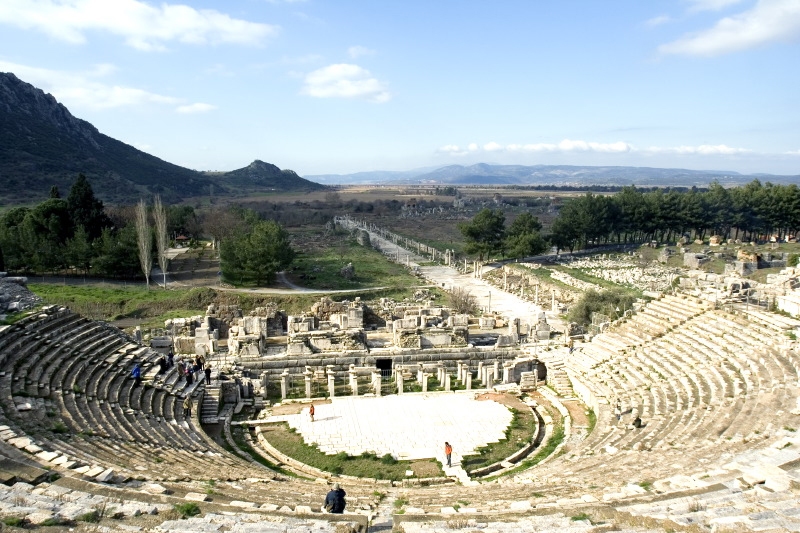
Excursus: The Artemision (Temple of Artemis)
Acts 19 also makes reference to the temple of Artemis in verses 27 and 35. Ephesus was known for their temple of Artemis (the Artemision). In fact, there is an inscription dating around 44 C.E. that captures the sentiment well: to te tēs Artemidos autēs hieron, ho tēs eparcheias holēs estin kosmos, meaning, "The temple of Artemis itself, which is the ornament of the entire province" (Trebilco "Asia," 323). There were actually two major temples for Artemis: the Archaic Artemision (sometime called Croesus's Artemision) which was built in 560-550 B.C.E, and the Later Artemision (also known as the Hellenistic Artemision) constructed from 334 to 250 B.C.E. The location of the temple is about 2400 meters (nearly a mile and half) east of the ancient harbor.
The sixth-century temple of Artemis is modeled closely after the Heraion at Samos, though the orientation of it is rotated 180 degrees to take advantage of light from the setting sun as the rituals for Artemis took place in the evening. Theodorus, a Samian, engineered both the temple at Samos and the one in Ephesus, and Rhoikos (another Samian) helped in Samos, while he worked with Chersiphron of Knossos on the Ephesus project, and Chersiphron's son, Metagenes, completed the construction (Lawrence, 91). The sixth-century Artemision was built in the Ionic Order of architecture.
The central cella was buried behind a columnar forest; there were two rows of eight columns at the front of the temple, nine columns in the back of the temple, and twenty-one columns along the long ends of the temple (which makes the temple longer than the Ionic order would normally permit). The two center columns were 24 feet apart (axis to axis), while the outer pairs of columns were 20 feet; the diameters of the columns were larger than six feet; at the back of Artemision there were nine columns, more equally spaced apart (Lawrence, 91). A good number of the columns had sculptural decoration on the lower section of the drum, which is following an Eastern practice (Biers, 160). Some of the Ionic capitals were dressed with rosettes instead of spirals, and it is suggested that these accompanied the columns that had relief sculpture on the lower drum (Lawrence, 93). The spira, which is the lower part of the base, had two concave moldings between three convex piping, a model later used at the temple of Athena Polias in Priene (Lawrence, 145). The columns were constructed entirely of marble.
The roof was made of terra cotta, but tiled with marble along the edges (Lawrence, 93). The cella was made of limestone, yet it was covered with a marble façade. Only small traces of the entablature are preserved, none of which include the architrave, the piece sitting directly on the columns (Dinsmoor, 131). The whole structure was 115 meters long by 50 meters wide.
Tradition records that it was burnt down on the night that Alexander was born in 356 B.C.E. According to Strabo, the temple was set on fire by a certain Herostratus, and so the citizens of Ephesus sold their own belongings and the pillars of the burnt temple to construct a new temple (Strabo Geog. 14.1.22). He also wrote that Alexander offered to cover all the expenses "on condition that he should have the credit therefore on the inscription, but they were unwilling, just as they would have been far more unwilling to acquire glory by sacrilege and a spoliation of the temple" (Strabo Geog. [LCL] 14.1.22).
The architects of the second temple were Paionios of Ephesus, Demetrius (a slave of the temple), and later Deinokrates (Lawrence, 147). This temple has an extra row of columns at the front and an opisthodomos, which is a false entrance opposite of the entrance to the cella. It was based on the old plan, but its floor was raised seven feet and the platform was surrounded by steps (Robertson, 147). It covered an area that was four times as large as the Parthenon in Athens, and was supported by a total number of 127 columns that each stood sixty feet tall (Bruce, 374). Its altar was discovered in 1965 (Oster "Ephesus," 2:545). The Later Artemision is the temple counted among the seven wonders of the ancient world, and was standing during Paul's time. It fell as a result of plundering from the Goths (c. 262 C.E.) and looting by Christians (Oster "Ephesus," 2:545). After years have passed since it was neglected with the end of paganism, the Artemision disappeared under layers of soil. It was rediscovered by J.T. Wood, a British archaeologist, in 1869. The Artemision was buried deep beneath the surface; the fourth-century Artemision lay under fifteen feet of alluvial soil (Robertson, 91). Now, only a single (reconstructed) column stands where the great Artemision once stood tall.
Image on the left is the plan of the early Artemision (Biers, 161); Image on the right is a scaled-down reproduction of the Artemision.
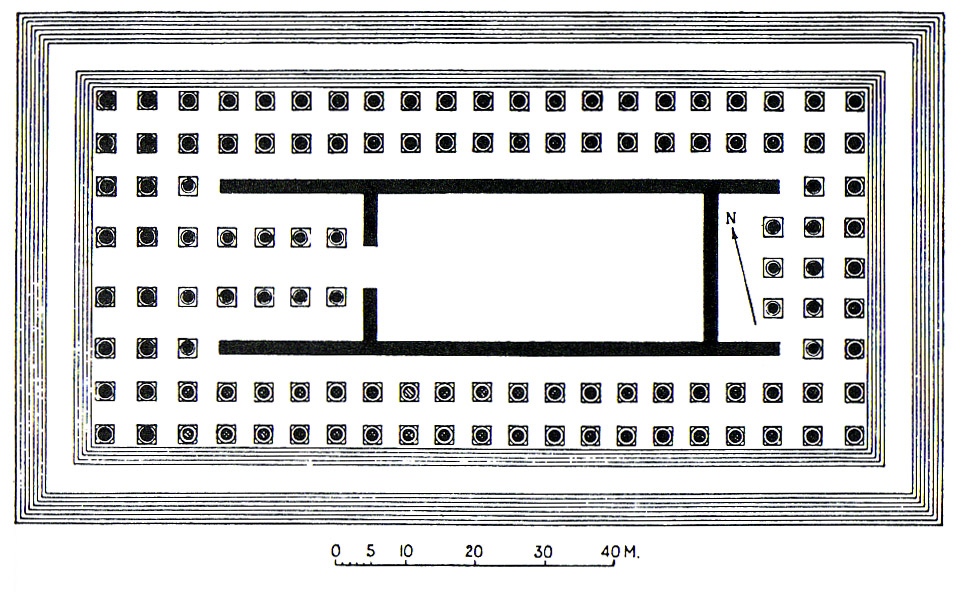
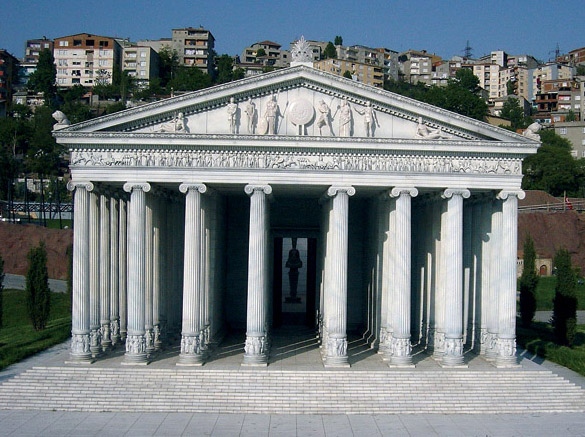
There is a lot of significance to this passage as the the three excursuses try to illuminate. Again, by use of litotes, Luke shows that the great disturbance arose in this leading city in response to the proliferation of Christianity ("the Way") in Ephesus. Luke puts on the mouth of Demetrius the words that reveal that Paul has persuaded not only Ephesus, but all Asia. Previously (19:10), all the residents of Asia had hear the word of the Lord, but now the message has penetrated further and all Asia is persuaded that hand-made gods are not really gods. Furthermore, the great stature of Artemis is now brought into question, this time, not only in Asia, but before the whole world. The result of this major section of Acts is that "the Way" is now capable of empire-wide notice.
Further Aegean Ministry (20:1-14)
1 After the uproar ceased, Paul sent for the disciples and having exhorted them took leave of them and departed for Macedonia. 2 When he had gone through these parts and had given them much encouragement, he came to Greece. 3 There he spent three months, and when a plot was made against him by the Jews as he was about to set sail for Syria, he determined to return through Macedonia. 4 Sopater of Beroea, the son of Pyrrhus, accompanied him; and of the Thessalonians, Aristarchus and Secundus; and Gaius of Derbe, and Timothy; and the Asians, Tychicus and Trophimus. 5 These went on and were waiting for us at Troas, 6 but we sailed away from Philippi after the days of Unleavened Bread, and in five days we came to them at Troas, where we stayed for seven days. 7 On the first day of the week, when we were gathered together to break bread, Paul talked with them, intending to depart on the morrow; and he prolonged his speech until midnight. 8 There were many lights in the upper chamber where we were gathered. 9 And a young man named Eutychus was sitting in the window. He sank into a deep sleep as Paul talked still longer; and being overcome by sleep, he fell down from the third story and was taken up dead. 10 But Paul went down and bent over him, and embracing him said, "Do not be alarmed, for his life is in him." 11 And when Paul had gone up and had broken bread and eaten, he conversed with them a long while, until daybreak, and so departed. 12 And they took the lad away alive, and were not a little comforted. 13 But going ahead to the ship, we set sail for Assos, intending to take Paul aboard there; for so he had arranged, intending himself to go by land. 14 And when he met us at Assos, we took him on board and came to Mitylene. (RSV)
Paul takes the opportunity to leave the circumstances in Ephesus and to visit Greece. While away, Paul raises a young man, Eutychus, from the dead.
This section functions as a break from the Ephesus panels. Luke tends to move his geography in circular fashion—Ephesus will show up again.
Paul and the Ephesian Elders (20:15-38)
15 And sailing from there we came the following day opposite Chios; the next day we touched at Samos; and the day after that we came to Miletus. 16 For Paul had decided to sail past Ephesus, so that he might not have to spend time in Asia; for he was hastening to be at Jerusalem, if possible, on the day of Pentecost. 17 And from Miletus he sent to Ephesus and called to him the elders of the church. 18 And when they came to him, he said to them: "You yourselves know how I lived among you all the time from the first day that I set foot in Asia, 19 serving the Lord with all humility and with tears and with trials which befell me through the plots of the Jews; 20 how I did not shrink from declaring to you anything that was profitable, and teaching you in public and from house to house, 21 testifying both to Jews and to Greeks of repentance to God and of faith in our Lord Jesus Christ. 22 And now, behold, I am going to Jerusalem, bound in the Spirit, not knowing what shall befall me there; 23 except that the Holy Spirit testifies to me in every city that imprisonment and afflictions await me. 24 But I do not account my life of any value nor as precious to myself, if only I may accomplish my course and the ministry which I received from the Lord Jesus, to testify to the gospel of the grace of God. 25 And now, behold, I know that all you among whom I have gone preaching the kingdom will see my face no more. 26 Therefore I testify to you this day that I am innocent of the blood of all of you, 27 for I did not shrink from declaring to you the whole counsel of God. 28 Take heed to yourselves and to all the flock, in which the Holy Spirit has made you overseers, to care for the church of God which he obtained with the blood of his own Son. 29 I know that after my departure fierce wolves will come in among you, not sparing the flock; 30 and from among your own selves will arise men speaking perverse things, to draw away the disciples after them. 31 Therefore be alert, remembering that for three years I did not cease night or day to admonish every one with tears. 32 And now I commend you to God and to the word of his grace, which is able to build you up and to give you the inheritance among all those who are sanctified. 33 I coveted no one's silver or gold or apparel. 34 You yourselves know that these hands ministered to my necessities, and to those who were with me. 35 In all things I have shown you that by so toiling one must help the weak, remembering the words of the Lord Jesus, how he said, 'It is more blessed to give than to receive.'" 36 And when he had spoken thus, he knelt down and prayed with them all. 37 And they all wept and embraced Paul and kissed him, 38 sorrowing most of all because of the word he had spoken, that they should see his face no more. And they brought him to the ship. (RSV)
Paul's mission now brought him back toward Ephesus, yet he bypassed the city to save time. Instead, he called for the Ephesian elders and addressed them in a speech in Miletus. After the speech, the elders send him on his way.
Photographs of Miletus. Images property of Pitts Theology Library.

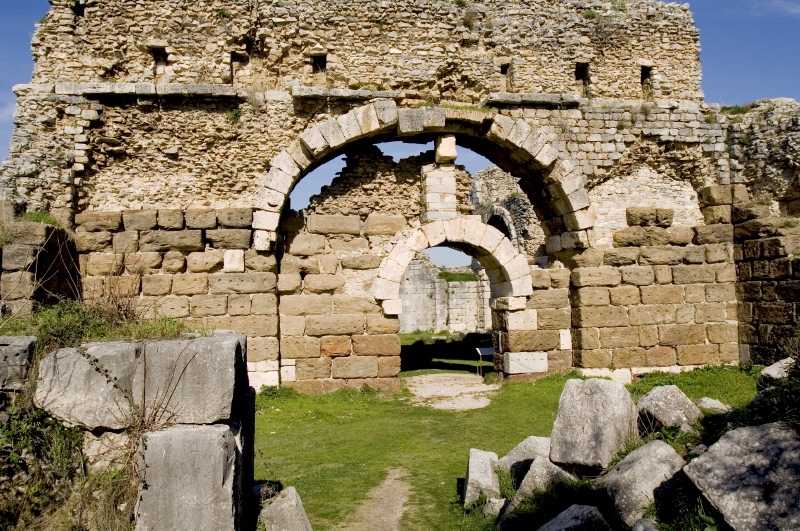
The speech that he delivered to the Ephesian elders functions as his farewell address to the elders, as well as his last admonishment to the church as a whole. In the speech he affirms his own ministry among the Ephesians and warns them of future, harmful movements (that may have reflected the period of Luke's own writing). Lastly, Paul leaves the Ephesian elders in charge of a well-established church, a new center for Christianity.

